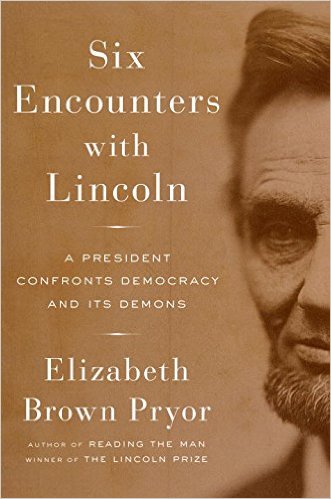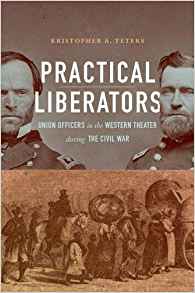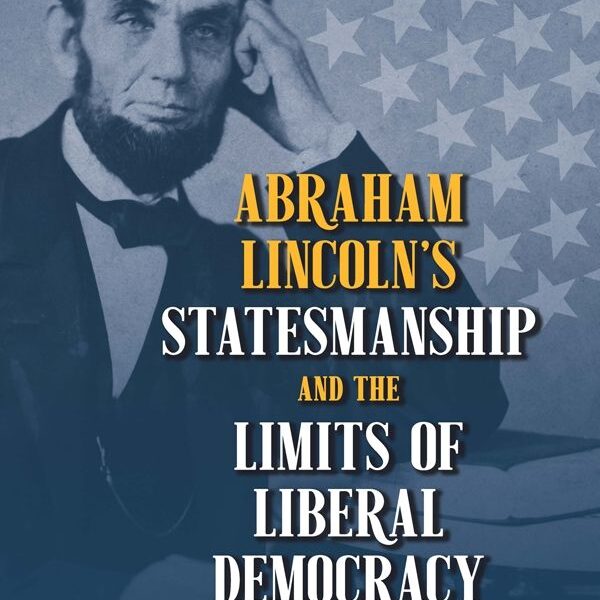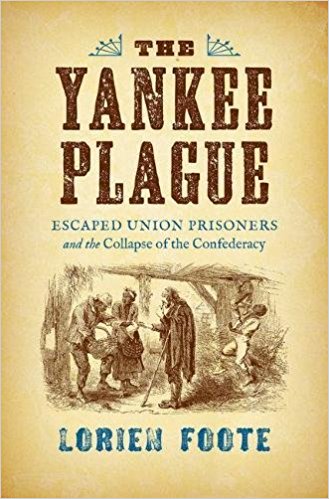Six Encounters with Lincoln: A President Confronts Democracy and Its Demons by Elizabeth Brown Pryor. Viking, 2017. Cloth, ISBN: 978-0670025909. $35.00.
 In Six Encounters with Lincoln, Elizabeth Brown Pryor seeks to get at the real Abraham Lincoln by peeling away the layers of mythology and exposing a flesh and blood human being. In doing so, Pryor employs what she acknowledges as an “unorthodox and provocative” approach. Rather than focus on Lincoln’s own writings, which she dismisses as “largely dull,” Pryor instead relies on the perceptions of Lincoln’s contemporaries. Suspicious of accounts that were penned after Lincoln’s assassination, Pryor privileges sources produced during his presidency by people who met with him. The book is organized into six thematic chapters that each uses an encounter as a starting point to explore a particular issue. This is indeed an intriguing way to approach Lincoln, but Pryor stacks the methodological deck by detailing encounters that did not go well. As a consequence, the portrait of Lincoln that emerges from the pages of Pryor’s book is precisely what one would expect from a sample largely comprised of disappointed callers at the White House, and reminiscent of the caricatures that his political adversaries produced to ridicule him.
In Six Encounters with Lincoln, Elizabeth Brown Pryor seeks to get at the real Abraham Lincoln by peeling away the layers of mythology and exposing a flesh and blood human being. In doing so, Pryor employs what she acknowledges as an “unorthodox and provocative” approach. Rather than focus on Lincoln’s own writings, which she dismisses as “largely dull,” Pryor instead relies on the perceptions of Lincoln’s contemporaries. Suspicious of accounts that were penned after Lincoln’s assassination, Pryor privileges sources produced during his presidency by people who met with him. The book is organized into six thematic chapters that each uses an encounter as a starting point to explore a particular issue. This is indeed an intriguing way to approach Lincoln, but Pryor stacks the methodological deck by detailing encounters that did not go well. As a consequence, the portrait of Lincoln that emerges from the pages of Pryor’s book is precisely what one would expect from a sample largely comprised of disappointed callers at the White House, and reminiscent of the caricatures that his political adversaries produced to ridicule him.
Pryor’s Lincoln is a ham-fisted, socially inept, ill-prepared, backwoods rube. Not wedded to one particular strain of the anti-Lincoln tradition, Pryor offers a pastiche of criticisms that range from a racist, reluctant emancipator to an incompetent, ego-driven commander-in-chief. The first chapter opens with the vignette of Lincoln holding a reception for army officers at the White House on March 12, 1861. Pryor notes that several soldiers came away unimpressed with their new leader, and she proceeds to explore Lincoln’s various deficiencies as commander-in-chief. It is speculated that if Lincoln had recognized the importance of discipline and acted more decisively at the outset of his administration, then fewer officers would have joined the rebellion. Despite inheriting a relatively small army headed by superannuated generals and filled with officers whose loyalty was questionable at best, Lincoln is taken to task for his lack of military experience, his failure to appreciate the value of martial culture, and his preference for political generals over professional officers. As a consequence of these flaws, Lincoln made several poor decisions, and rather than growing into the job, Pryor asserts that he never understood “professionally trained soldiers took pride in obeying civil authorities regardless of political viewpoint.” Such a claim is dubious at best when one considers the difficulties Lincoln faced from some of his West Point-educated generals—most notably George McClellan—who essentially threatened a mutiny if Lincoln broadened the aims of the war to include emancipation.
In a chapter that discusses Lincoln’s meetings with Democratic newspaper editor and longtime Washington insider Duff Green, Pryor echoes revisionist historians of the 1930s by suggesting that Lincoln deserves much of the blame for provoking the South and “blundering” into a war that was not necessarily inevitable. Acting as an emissary from President Buchanan in December 1860, Green sought Lincoln’s endorsement of a compromise over the expansion of slavery in the hope that this would stave off secession. Lincoln wrote a response that reiterated his position of non-interference with slavery in the states where it already existed and consented to the publication of the statement on the condition that half of the remaining senators from the Deep South sign a pledge to cease all agitation for secession. Pryor believes Lincoln was unreasonable in his determination to maintain his core principle of opposing the further expansion of slavery, and she criticizes his refusal to issue a public statement during the secession crisis. Pryor uses the April 1865 meeting with Green to explore Lincoln’s failed plans for Reconstruction and his poor reputation among Southerners. For Pryor, the two meetings with Green encapsulate Lincoln’s fundamental failure to understand the South. This is a valid point, for Lincoln clearly overestimated the level of Southern unionism in 1860-61 and underestimated their attachment to slavery. Lincoln’s fundamental misreading of the white South makes Pryor’s criticism of his failure to issue reassurances during the secession crisis all the more unconvincing. Short of reversing his principles and refusing to take the oath of office, as some Southerners urged him to do, it seems there was little else Lincoln could have done to placate them.
While the chapter on Duff Green reflects a revisionist critique of Lincoln, chapters that feature encounters with a common soldier, Principal Chief John Ross of the Cherokee Nation, and Harriet Beecher Stowe offer a presentist critique of Lincoln’s “myopic” view of democracy that did not encompass African Americans, Indians, and women. According to Pryor, Lincoln possessed a “fundamental racism” that was little changed by his experiences during the war. Lucien Watters, a soldier in the 11th New York Cavalry, was part of the detachment that guarded Lincoln during the trying summer of 1862, and Pryor researched a fascinating collection of Watters’ letters that details his efforts to aid contrabands. In one of the letters, he provides a brief account of an encounter when he approached the president with a request for a furlough. Watters did not receive the furlough, and he reported to his brother that Lincoln treated him brusquely and asked if his request had something to do with the “niggar” question. For Pryor, this brief meeting captures both Lincoln’s “cultural boorishness” and his failure to be a leader in promoting racial equality. Pryor alleges that Lincoln not only frequently used racial epithets but also opposed progress for black Americans by dragging his feet on emancipation and urging that freed slaves be colonized outside the United States. Much like Lerone Bennett, Pryor concludes that circumstances forced Lincoln to alter his policies.
If Lincoln’s views on African Americans were lacking, Pryor argues that his Indian policy was nothing short of “catastrophic.” A September 1862 meeting with John Ross is used as a window into his role as “Great Father.” In surveying Lincoln’s attitude towards Indians, Pryor concludes that he did not seem to think they merited the natural rights outlined in the Declaration of Independence. Though Pryor downplays the incident, Lincoln’s decision to commute the sentences of 262 of the 300 Sioux sentenced to death for their roles in an 1862 Minnesota uprising indicates that he believed Indians were entitled to some rights as human beings. He certainly gave them far more consideration than military officials, politicians, and citizens in Minnesota were willing to grant, as they urged all of them be hanged and offered to do it if Lincoln was too squeamish to have it done under federal authority. David Nichols persuasively argues in Lincoln and the Indians that Lincoln hoped to reform Indian relations, but was too consumed by the war to devote adequate attention to the matter. As a consequence, while Lincoln’s intentions may have been good, his policies were no worse than other presidents; yet Pryor seems unwilling to acknowledge that he had more pressing concerns.
Lincoln’s December 1862 meeting with Harriet Beecher Stowe is used to explore his interactions with women and further emphasize his nearsighted vision of democracy. While Pryor claims Stowe came away unimpressed by Lincoln, there is no evidence to support this claim, since Stowe did not write about the encounter. Instead, Pryor selectively quotes from an account by Stowe’s sister-in-law and fails to mention that Stowe published a favorable piece on Lincoln in 1864. Pryor details Lincoln’s “chronic social clumsiness” in his relations with women, including his troubled courtship of Mary Todd and his unpopularity with Anna E. Dickinson; he is chastised for not adequately recognizing the contributions women made to the war effort and failing to find the time to meet with Jane Swisshelm and Clara Barton. Clearly, Lincoln could neither meet nor satisfy everyone whom he met. While Lucien Watters and John Ross came away disappointed and Clara Barton was upset that she was unable to see Lincoln, other encounters tell different stories. Lincoln’s meetings with Martin Delany; Frederick Douglass; the widow of the commanding officer at Fort Pillow, Eliza Gurney; and a delegation of African Americans who presented him with a Bible as a token of their appreciation for the Emancipation Proclamation offer opportunities for further exploration that would cast Lincoln in a more complex, nuanced light.
Prior to writing Encounters with Lincoln, Pryor wrote a prize-winning study of Robert E. Lee. Although Lee is mentioned only a few times, he is employed as a foil that echoes of the Lost Cause. While Lincoln had a “strange gargoyle of a face,” and probably a “gap-toothed, jack-o’-lantern grin,” Lee possessed “matinee-idol looks.” Lincoln lacked military bearing, was a poor conversationalist, and had a “goofy appearance,” yet Lee possessed “magnetism,” “military bearing,” and was the “most striking figure” in the room at the March 12, 1861, White House reception. Lincoln told ribald stories peppered with racial epithets, but Pryor claims Lee never used the word “nigger.” After Lee resigned from the army and joined the rebellion, Lincoln allegedly “showed an uncharacteristic vengefulness toward Lee for the rest of his life,” yet letting him off the hook at Appomattox is described as perhaps Lincoln’s greatest achievement. Pryor believes “This was the moment that made the man.” Lincoln comes off as a petty, fumbling buffoon more concerned with satisfying his personal ambition and defending his thin skin from critics than with preserving the Union, vindicating republican government, or abolishing slavery.
Lincoln was deeper and more complicated than Pryor appears willing to admit. In concluding the book with a brief discussion of Lincoln’s admiration of Shakespeare, she laments the Bard’s lack of influence on Lincoln by dismissing Lincoln’s speeches and writings as “banal,” “workmanlike,” and “so clumsily phrased as to be obtuse.” This rather harsh assessment is not supported by a serious effort to analyze Lincoln’s words. Fitting with her characterization of Lincoln as a clown, Pryor refers to his rail journey to Washington in February 1861 as a “traveling circus” and emphasizes his misstep in using the term “artificial” to describe the secession crisis, yet does not mention his speech at Independence Hall in Philadelphia where he eloquently defended the principles embodied in the Declaration of Independence. What turned out to be Lincoln’s final public address on April 11, 1865, is described as a “rambling” effort that left the audience “bored and disappointed.” The reader is given no indication that Lincoln recommended black suffrage in this speech, and that that suggestion so outraged one listener that he made sure it would be Lincoln’s last speech by murdering him three nights later.
Lincoln’s critics were legion during his presidency, and no matter what he did it was impossible to please everyone. Readers unfamiliar with how unpopular Lincoln was during his lifetime will find Pryor’s book eye opening. Her quest to reveal the real Lincoln through all of the myths is a task that Lincoln’s law partner, William H. Herndon, set out to accomplish in 1865. Herndon personally knew Lincoln about as well as anyone could hope to, and like Pryor, he concluded that Lincoln was “unsocial” and “did not care for men.” In Lincoln, Herndon saw “the most secretive—reticent—shut-mouthed man that Ever Existed.” He was, in Herndon’s estimation, a “mystery to the world,” and Pryor attempts to crack this enigma by relying on those who only caught a glimpse of the man and came away disappointed. There is plenty of room for serious, scholarly criticism of Lincoln’s policies and views on a variety of subjects, but Pryor’s formula for solving the riddle of Abraham Lincoln is one-sided. Her portrait of a shallow ruler lacks what Herndon concluded was more important to understanding Lincoln than his interactions with individuals: his firm commitment to principles.1
Matthew Norman is Associate Professor of History at the University of Cincinnati, Blue Ash College.
1. William H. Herndon to J.E. Remsburg, September 10, 1887, in Douglas L. Wilson and Rodney O. Davis, eds., Herndon on Lincoln: Letters (Champaign: University of Illinois Press, 2016), 257-58.




